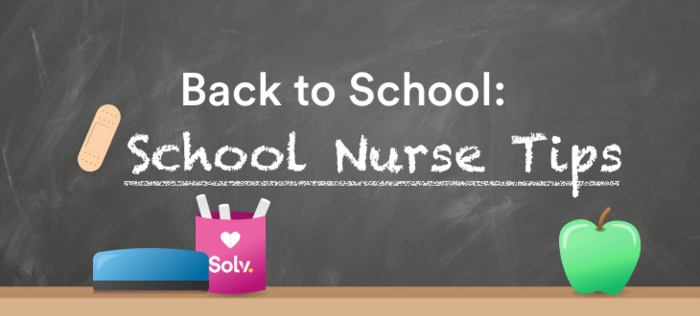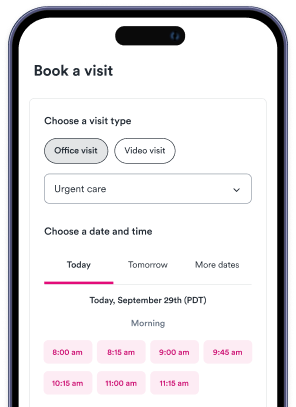Key points
- Ensure your child's immunizations are up-to-date to protect them from preventable diseases and comply with school immunization laws.
- Schedule annual well-child exams to monitor your child's physical, mental, and emotional development and identify potential health issues early.
- Prepare for the school year by updating medication forms, delivering necessary medications to the school nurse, and submitting relevant physician care plans.
- Establish good sleep hygiene, balanced nutrition, and open conversations about bullying to support your child's emotional, physical, and academic well-being.

We spoke with Amy Huey, head school nurse at University Park Elementary, to get her top tips for keeping kids healthy and safe as they return to the classroom. We also pulled in expert guidance from leading public health organizations like the CDC, Mayo Clinic, and NYC Health to expand on Nurse Huey’s suggestions.
As summer winds down, families across the country are scrambling to finish supply runs, book physicals, and squeeze in last-minute vacations. Meanwhile, school nurses are preparing for the arrival of excited (and sometimes anxious) students—some healthy, some sniffly, and all in need of support.
From vaccinations to sleep schedules, here are ten essential back-to-school health tips to help your child start strong and stay well all year long.
1. Make sure immunizations are up to date
Vaccines are one of the most effective ways to protect your child from preventable diseases. School immunization laws help reduce outbreaks of measles, whooping cough, and other serious illnesses.
Double-check your child’s records and schedule any needed boosters before school starts. Key vaccine check-in points include:
-
Kindergarten: DTaP, MMR, Varicella, Polio
-
7th grade: Tdap booster, Meningococcal vaccine
-
12th grade: Additional meningococcal vaccine for some
-
College-bound teens: Tdap and meningitis boosters if not already administered
Some states require proof of immunization for school entry, so confirm what’s needed with your child’s school or pediatrician. Many urgent care clinics offer same-day vaccine appointments for added convenience.
2. Schedule a well-child exam—every year
Annual well-child visits are about more than just vaccinations. They’re a critical checkpoint for your child’s physical, mental, and emotional development. These exams provide a full review of your child’s medical history and may include screenings for mental health, vision, hearing, and growth tracking.
During the visit, your provider may:
-
Monitor growth and development patterns
-
Address any behavioral, academic, or sleep concerns
-
Review past medical issues and anticipate future needs
-
Identify conditions like scoliosis, ADHD, or anxiety early on
Even if your child seems healthy, a well-child check can catch potential problems before they interfere with school or daily life.
3. Double-check medications and action plans
If your child takes medication at school or has a condition like asthma, allergies, or diabetes, now’s the time to prepare. Every school year requires fresh documentation.
-
Submit a signed daily medication form.
-
Deliver properly labeled, unexpired medications to the school nurse.
-
Update and submit relevant physician care plans:
-
Asthma action plan
-
Allergy action plan
-
Diabetes orders
-
Seizure plan
-
Self-carry authorization for inhalers or epinephrine
-
With over 25% of school-aged children managing chronic conditions, communication between parents, providers, and schools is essential for day-to-day safety and care.
4. Prioritize vision and hearing screenings
Vision and hearing problems are among the most common undiagnosed barriers to classroom success. Undetected issues can lead to difficulty reading, missed instructions, behavior challenges, and academic frustration.
What to do:
-
Confirm your child has had recent vision and hearing screenings. These are often done during well-child exams but can also be performed at school or by specialists.
-
Watch for signs such as squinting, sitting too close to screens, frequent ear infections, inattentiveness, or turning the head to hear.
-
Notify your school nurse if your child wears glasses, uses a hearing aid, or has a diagnosed sensory issue.
Early detection helps set your child up for success both socially and academically.
5. Get clearance for sports and physical activity
More than 57 million youth in the U.S. participate in organized sports—and most schools require an annual physical for participation.
-
Schedule your child’s sports physical and submit any clearance forms required by the school or team.
-
After an injury or illness, provide documentation of any restrictions or return-to-play clearance, especially for concussions.
-
Inquire about optional cardiac screenings like EKGs, especially if your child has a family history of heart issues.
Health screenings help prevent serious complications and ensure your child is physically ready to engage in athletics.
6. Reinforce a stay-home-when-sick policy
While inconvenient, keeping your child home when sick helps reduce the spread of illness and protects both classmates and teachers. Illness-related absences can also disrupt your child’s learning and make it harder to catch up.
Here’s how to prepare:
-
Learn your school’s policies for exclusion: children should be fever-free without medication for 24 hours and free of vomiting or diarrhea before returning.
-
Teach handwashing routines and cover-your-cough hygiene.
-
Keep your child’s immune system strong with consistent sleep, hydration, and healthy meals.
-
Add your school and clinic contact numbers to your phone in case the nurse calls during the day.
If your pediatrician’s schedule is full, urgent care centers can be a helpful option for same-day care.
7. Establish good sleep hygiene
Sleep is essential for attention, behavior, emotional regulation, and physical health. School-aged children need between 9–12 hours of sleep each night.
To improve sleep quality:
-
Begin adjusting sleep schedules 1–2 weeks before the first day of school.
-
Create a calm, screen-free bedtime routine.
-
Keep the bedroom cool, dark, and quiet.
-
Limit caffeine and late-night snacks.
-
Remove TVs and mobile devices from the bedroom.
Poor sleep is linked to behavioral issues and reduced academic performance. A strong routine makes mornings easier and learning more effective.
8. Focus on balanced nutrition
Nutrition fuels learning. Kids who eat well are more likely to concentrate, retain new information, and regulate their moods.
Support healthy eating habits by:
-
Encouraging breakfast daily—even a simple combo of protein and whole grains can improve focus.
-
Packing snacks like fruits, yogurt, whole grain crackers, or nuts.
-
Replacing juice or soda with water to reduce sugar intake.
-
Choosing whole grain versions of breads and pastas.
-
Offering a variety of fruits, vegetables, lean proteins, and healthy fats at meals.
Use the “5-2-1-0” rule as a guide: 5 fruits and veggies, 2 hours or less of screen time, 1 hour of activity, and 0 sugary drinks per day.
9. Talk about bullying—before it starts
Bullying can seriously impact a child’s emotional and academic well-being. Early conversations can empower children and prevent harm.
Teach your child:
-
It’s okay to ask for help. Encourage them to report bullying to an adult.
-
How to assert themselves calmly with phrases like “please stop” or “that’s not okay.”
-
That walking away or changing locations is sometimes the safest response.
-
How to support peers who are being targeted.
Also watch for signs of bullying such as school avoidance, sleep problems, withdrawal, or mood changes. Stay connected with teachers, coaches, and school counselors to ensure your child feels safe.
10. Keep the nurse informed—even if it seems minor
Your school nurse is a vital member of your child’s care team. Sharing relevant health updates, even small ones, helps ensure your child gets appropriate support during the day.
Be sure to report:
-
New diagnoses or changes in medication
-
History of seasonal or food allergies
-
Asthma triggers, seizure history, or mental health concerns
-
Oral immunotherapy or medical devices in use
-
Past emergency room visits or hospitalizations
More than 40% of students have a chronic or complex health condition. Partnering with the nurse means faster response times and safer outcomes if something goes wrong.
Final thoughts
Back-to-school season is a time of new beginnings. By planning ahead, keeping the lines of communication open, and focusing on your child’s physical and emotional health, you can help them start the year strong.
Whether it’s scheduling a check-up, packing nutritious lunches, or setting a consistent bedtime, each step plays a role in building a healthy foundation for the year ahead. And remember: your school nurse is here to help.
FAQs
What are some important health-related preparations for a child going back to school?
Parents should ensure their child's immunizations are up to date, schedule annual well-child exams, double-check medications and action plans if the child has a chronic condition, prioritize vision and hearing screenings, get clearance for sports and physical activities, reinforce a stay-home-when-sick policy, establish good sleep hygiene, focus on balanced nutrition, talk about bullying, and keep the school nurse informed of any health updates or concerns.
Why are annual well-child exams important?
Annual well-child exams are more than just vaccinations. They serve as a critical checkpoint for a child’s physical, mental, and emotional development. These exams provide a full review of a child’s medical history and may include screenings for mental health, vision, hearing, and growth tracking. They can help identify conditions like scoliosis, ADHD, or anxiety early on and catch potential problems before they interfere with school or daily life.
What should parents do if their child takes medication at school or has a chronic condition?
Parents should prepare by submitting a signed daily medication form, delivering properly labeled, unexpired medications to the school nurse, and updating and submitting relevant physician care plans. Communication between parents, providers, and schools is essential for day-to-day safety and care.
How can parents help their child succeed academically and socially?
Parents can help their child succeed by ensuring they have recent vision and hearing screenings, as undetected issues can lead to difficulty reading, missed instructions, behavior challenges, and academic frustration. Early detection helps set the child up for success both socially and acadically. Additionally, parents should establish good sleep hygiene and focus on balanced nutrition as these factors can greatly impact a child's attention, behavior, emotional regulation, and physical health.
What is the role of the school nurse and how can parents collaborate with them?
The school nurse is a vital member of a child’s care team. Parents should keep the nurse informed of any relevant health updates, even minor ones, to ensure the child gets appropriate support during the day. This includes new diagnoses or changes in medication, history of seasonal or food allergies, asthma triggers, seizure history, or mental health concerns, oral immunotherapy or medical devices in use, and past emergency room visits or hospitalizations. This partnership means faster response times and safer outcomes if something goes wrong.









